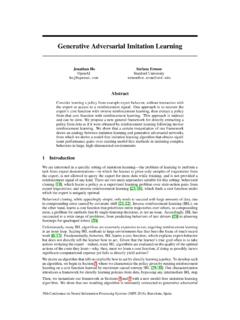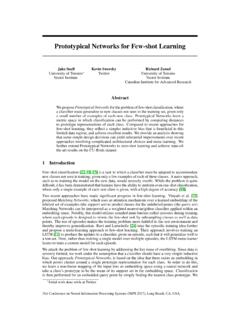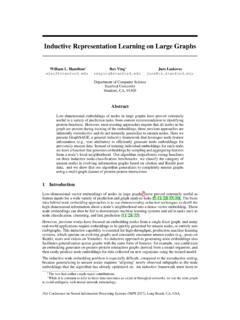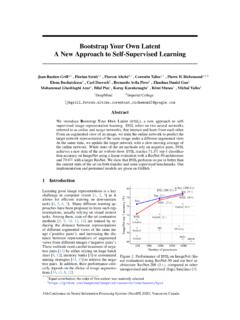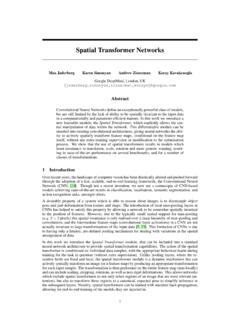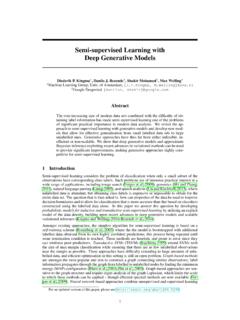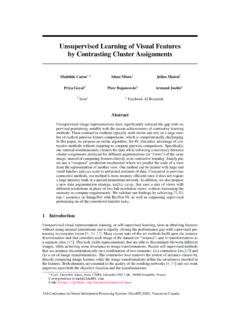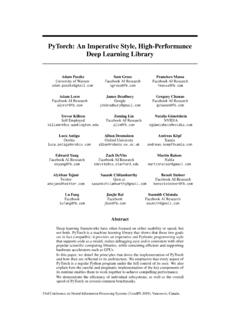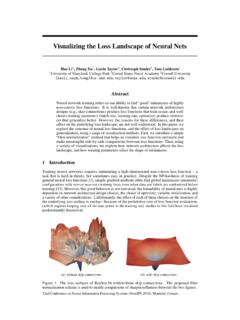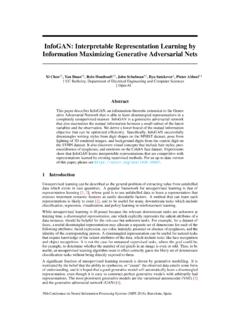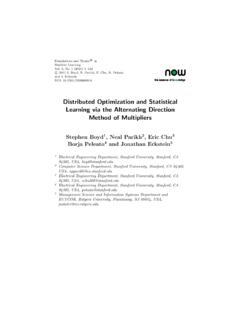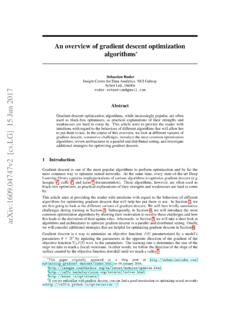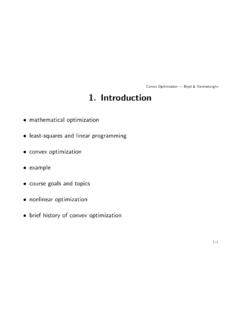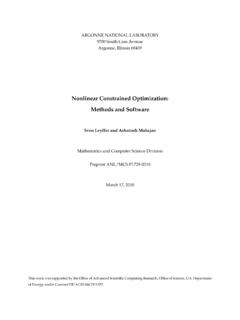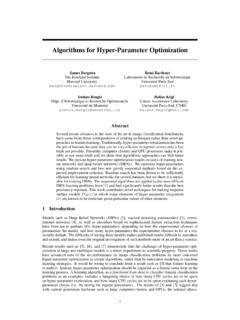Transcription of Learning Combinatorial Optimization Algorithms over …
1 Learning Combinatorial Optimization Algorithms over GraphsHanjun Dai , Elias B. Khalil , Yuyu Zhang , Bistra Dilkina , Le Song College of Computing, Georgia Institute of Technology Ant Financial{ , , , bdilkina, design of good heuristics or approximation Algorithms for NP-hard combi-natorial Optimization problems often requires significant specialized knowledgeand trial-and-error. Can we automate this challenging, tedious process, and learnthe Algorithms instead? In many real-world applications, it is typically the casethat the same Optimization problem is solved again and again on a regular basis,maintaining the same problem structure but differing in the data. This providesan opportunity for Learning heuristic Algorithms that exploit the structure of suchrecurring problems. In this paper, we propose a unique combination of reinforce-ment Learning and graph embedding to address this challenge.}
2 The learned greedypolicy behaves like a meta- algorithm that incrementally constructs a solution, andthe action is determined by the output of a graph embedding network capturingthe current state of the solution. We show that our framework can be applied to adiverse range of Optimization problems over graphs, and learns effective algorithmsfor the Minimum Vertex Cover, Maximum Cut and Traveling Salesman IntroductionCombinatorial Optimization problems over graphs arising from numerous application domains, suchas social networks, transportation, telecommunications and scheduling, are NP-hard, and have thusattracted considerable interest from the theory and algorithm design communities over the years. Infact, of Karp s 21 problems in the seminal paper on reducibility [19], 10 are decision versions of graphoptimization problems, while most of the other 11 problems, such as set covering, can be naturallyformulated on graphs.
3 Traditional approaches to tackling an NP-hard graph Optimization problemhave three main flavors: exact Algorithms , approximation Algorithms and heuristics. Exact algorithmsare based on enumeration or branch-and-bound with an integer programming formulation, but maybe prohibitive for large instances. On the other hand, polynomial-time approximation Algorithms aredesirable, but may suffer from weak optimality guarantees or empirical performance, or may not evenexist for inapproximable problems. Heuristics are often fast, effective Algorithms that lack theoreticalguarantees, and may also require substantial problem-specific research and trial-and-error on the partof algorithm three paradigms seldom exploit a common trait of real-world Optimization problems: instancesof the same type of problem are solved again and again on a regular basis, maintaining the samecombinatorial structure, but differing mainly in their data.
4 That is, in many applications, values ofthe coefficients in the objective function or constraints can be thought of as being sampled from thesame underlying distribution. For instance, an advertiser on a social network targets a limited set ofusers with ads, in the hope that they spread them to their neighbors; such covering instances needto be solved repeatedly, since the influence pattern between neighbors may be different each , a package delivery company routes trucks on a daily basis in a given city; thousands ofsimilar optimizations need to be solved, since the underlying demand locations can differ. Both authors contributed equally to the Conference on Neural Information Processing Systems (NIPS 2017), Long Beach, CA, the graph + partial solutionGreedy node selection1stiteration2nditeration ReLuReLuReLuReLuEmbed graphGreedy: add best nodeEmbed graphGreedy: add best nodeFigure 1:Illustration of the proposed framework as applied to an instance of Minimum Vertex Cover.
5 Themiddle part illustrates two iterations of the graph embedding, which results in node scores (green bars).Despite the inherent similarity between problem instances arising in the same domain, classicalalgorithms do not systematically exploit this fact. However, in industrial settings, a company maybe willing to invest in upfront, offline computation and Learning if such a process can speed up itsreal-time decision-making and improve its quality. This motivates the main problem we address:Problem Statement:Given a graph Optimization problemGand a distributionDof probleminstances, can we learn better heuristics that generalize to unseen instances fromD?Recently, there has been some seminal work on using deep architectures to learn heuristics forcombinatorial problems, including the Traveling Salesman Problem [37,6,14]. However, thearchitectures used in these works are generic, not yet effectively reflecting the Combinatorial structureof graph problems.
6 As we show later, these architectures often require a huge number of instances inorder to learn to generalize to new ones. Furthermore, existing works typically use the policy gradientfor training [6], a method that is not particularly sample-efficient. While the methods in [37,6] canbe used on graphs with different sizes a desirable trait they require manual, ad-hoc input/outputengineering to do so ( padding with zeros).In this paper, we address the challenge of Learning Algorithms for graph problems using a uniquecombination of reinforcement Learning and graph embedding. The learned policy behaves like ameta- algorithm that incrementally constructs a solution, with the action being determined by a graphembedding network over the current state of the solution. More specifically, our proposed solutionframework is different from previous work in the following aspects:1.
7 algorithm design will adopt agreedymeta- algorithm design, whereby a feasiblesolution is constructed by successive addition of nodes based on the graph structure, and is maintainedso as to satisfy the problem s graph constraints. Greedy Algorithms are a popular pattern for designingapproximation and heuristic Algorithms for graph problems. As such, the same high-level design canbe seamlessly used for different graph Optimization algorithm will use agraph embeddingnetwork, calledstructure2vec(S2V) [9], to represent the policy in the greedy algorithm . This novel deep Learning architectureover the instance graph featurizes the nodes in the graph, capturing the properties of a node in thecontext of its graph neighborhood. This allows the policy to discriminate among nodes based ontheir usefulness, and generalizes to problem instances of different sizes.
8 This contrasts with recentapproaches [37,6] that adopt a graph-agnostic sequence-to-sequence mapping that does not fullyexploit graph algorithm will use fittedQ- Learning to learn a greedy policy that is parametrizedby the graph embedding network. The framework is set up in such a way that the policy will aimto optimize the objective function of the original problem instancedirectly. The main advantage ofthis approach is that it can deal with delayed rewards, which here represent the remaining increase inobjective function value obtained by the greedy algorithm , in a data-efficient way; in each step of thegreedy algorithm , the graph embeddings are updated according to the partial solution to reflect newknowledge of the benefit ofeach nodeto the final objective value. In contrast, the policy gradientapproach of [6] updates the model parameters only once the whole solution ( the tour inTSP).
9 2 The application of a greedy heuristic learned with our framework is illustrated in Figure 1. Todemonstrate the effectiveness of the proposed framework, we apply it to three extensively studiedgraph Optimization problems. Experimental results show that our framework, a single meta-learningalgorithm, efficiently learns effective heuristics for each of the problems. Furthermore, we show thatour learned heuristics preserve their effectiveness even when used on graphs much larger than theones they were trained on. Since many Combinatorial Optimization problems, such as the set coveringproblem, can be explicitly or implicitly formulated on graphs, we believe that our work opens up anew avenue for graph algorithm design and discovery with deep Common Formulation for Greedy Algorithms on GraphsWe will illustrate our framework using three Optimization problems over weighted graphs.
10 LetG(V, E, w)denote a weighted graph, whereVis the set of nodes,Ethe set of edges andw:E!R+the edge weight function, (u, v)is the weight of edge(u, v)2E. These problems are: Minimum Vertex Cover (MVC):Given a graphG, find a subset of nodesS Vsuch that everyedge is covered, (u, v)2E,u2 Sorv2S, and|S|is minimized. Maximum Cut (MAXCUT):Given a graphG, find a subset of nodesS Vsuch that the weightof the cut-setP(u,v)2Cw(u, v)is maximized, where cut-setC Eis the set of edges with oneend inSand the other end inV\S. Traveling Salesman Problem (TSP):Given a set of points in 2-dimensional space, find a tourof minimum total weight, where the corresponding graphGhas the points as nodes and is fullyconnected with edge weights corresponding to distances between points; a tour is a cycle that visitseach node of the will focus on a popular pattern for designing approximation and heuristic Algorithms , namelya greedy algorithm .
